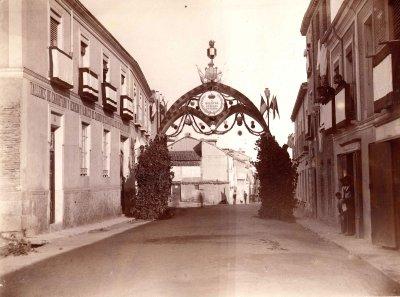The dawn of photography in Guadalajara
 The capital of Alcarria lived, during the second half of the 19th century, a certain cultural and scientific splendor as a result of the establishment and consolidation in the city of various centers that stimulate knowledge and science, such as the Superior Academy of Military Engineers and the annexed Aerostation Park , the Normal School of Teaching and the Institute of Secondary Education, in whose shadow many other associations of free thought and recreation were born, such as the Peña, the Ateneo Caracense, or the Obrero. It is significant that in 1922, when the Academy of Historical Research was founded, a Photography Section was included, which was left in charge of Francisco GOÑI and Enrique DIGES.
The capital of Alcarria lived, during the second half of the 19th century, a certain cultural and scientific splendor as a result of the establishment and consolidation in the city of various centers that stimulate knowledge and science, such as the Superior Academy of Military Engineers and the annexed Aerostation Park , the Normal School of Teaching and the Institute of Secondary Education, in whose shadow many other associations of free thought and recreation were born, such as the Peña, the Ateneo Caracense, or the Obrero. It is significant that in 1922, when the Academy of Historical Research was founded, a Photography Section was included, which was left in charge of Francisco GOÑI and Enrique DIGES.
Perhaps we could consider that date, 1922, as the end of a first period of photography in Guadalajara, that of the pioneers.
As always, the proximity to Madrid was an immediate influence in those initial moments; first with the visit and sporadic work of foreign photographers, such as the British Charles CLIFFORD (c.1855-1856), or French jean laurent (1870). Second, with the occasional presence of commercial photographers such as Ramon SAEZ (1853), Amador CUESTA, either Florencio Navarro who would settle in Guadalajara from 1883, occupying the office that Francisco EYRÉ and Vicente VÁZQUEZ had opened in 1864, at number 44 Calle Mayor. NAVARRO and his Successors of Navarro would be followed by many others who tried to break through in Guadalajara. We should mention, among others, Manuel ARIZA (since 1897), Francisco MARÍ(1906), ANGEL ARQUER (1912) or, the already cited Francisco GONI (1918), dedicated more to press photography. But the true engine of photography in Guadalajara will be the Photographic Service. This body linked to the Military Aerostation, in addition to attending to its own military interests, functioned as a true school for photographers, later incorporated into civil society. Professionals as prestigious and creative as JOSE ORTIZ ECHAGUE, Eduardo SUSANNA, or José REYES RUIZ, all of them members of the pictorialist currents. The latter would open, in 1925, his own cabinet on Román Atienza street, still in operation today. The material used then by Mr. José REYES (camera, enlargers, furniture and lighting system), and which served to immortalize the image of several generations, today is used to reproduce an ideal photographic study from the first quarter of the 20th century. Finally, this fleeting review of the dawn of photography in Guadalajara should not forget those fans who, with their heavy machines, toured the province capturing its landscapes, types, customs, and wealth of heritage. From Santiago MARTÍNEZ PALACIOS (1884), to Tomás CAMARILLO, through Jacinto ABÓS (1910), or the architect Antonio VÁZQUEZ FIGUEROA (1907).
